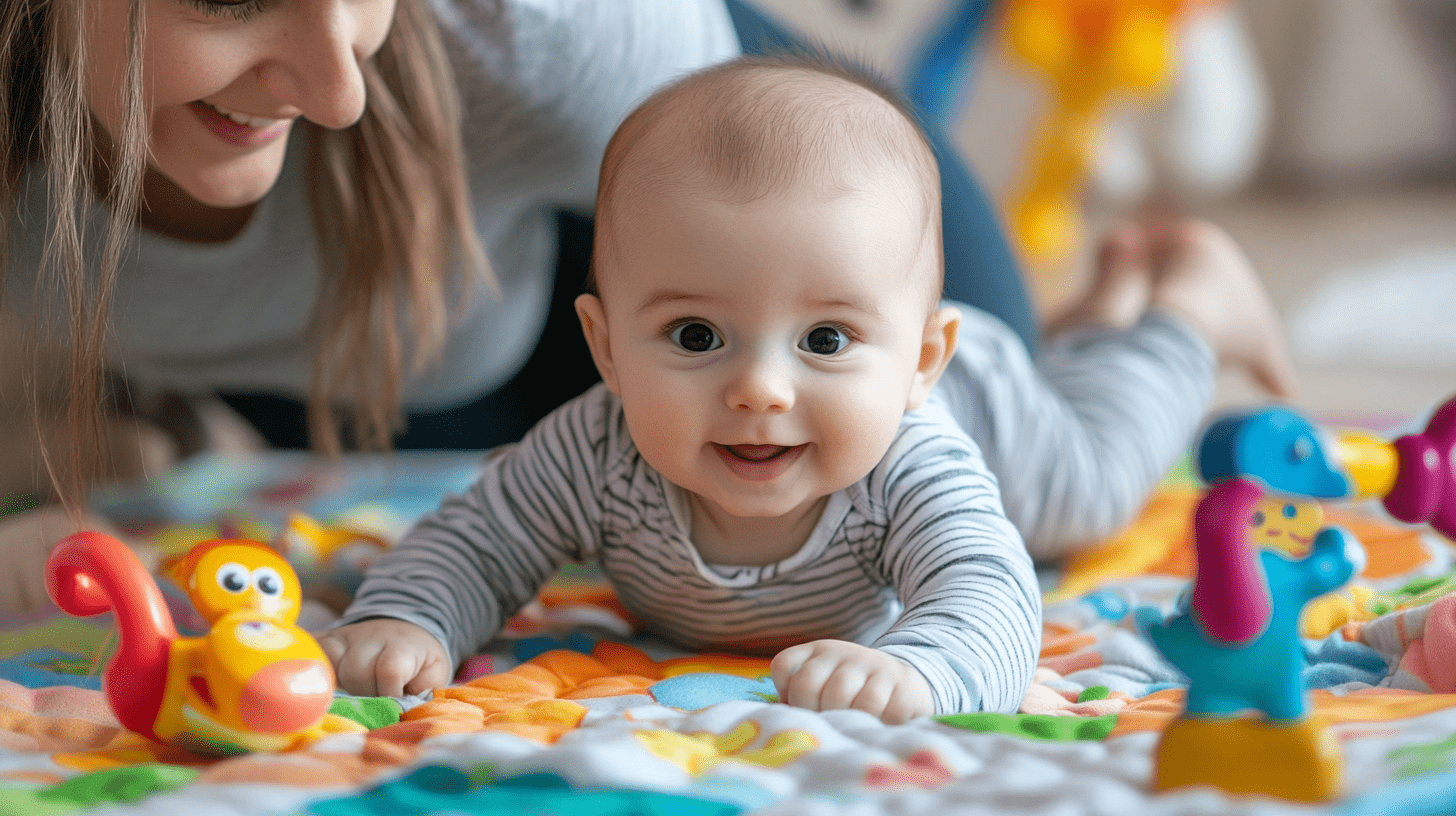- Tummy Time: It’s a classic but for a good reason! Laying your baby on their stomach develops crucial neck and shoulder muscles. Start with a few minutes of supervised play and gradually increase to 20 minutes. Get down on the floor with them, smile, and sing—this makes the experience enjoyable!
- Sit-Ups: No gym required! Gently pulling your baby into a sitting position strengthens their core and back. Start at around six weeks old, pulling them gently by the forearms while ensuring head support. This interactive movement is rewarding for both of you, especially as their progress becomes more noticeable.
- Bicycling Legs: A playful way to ease tummy troubles and strengthen those legs! While your baby lies on their back, mimic cycling motions with their legs. Be playful—make sound effects, and sing while you go! Repeat a few cycles or until your baby is fully engaged and enjoying the interaction.
- Weight Lifting: Turn playtime into strength training by introducing some fun “weights” around your house! Once your baby can grasp objects, use rattles or tiny toys to develop their hand-eye coordination and arm strength. Watch their excitement as they grasp, lift, and explore!
These simple exercises aren’t just for muscle development—they create wonderful bonding moments. By incorporating play into their physical activities, you’re fostering a nurturing environment where your child can thrive and grow, setting them up for a lifetime of health and activity. So, roll out that play mat and let the strength-building adventures begin!
4 Exercises That Help Your Baby Get Stronger
Your baby is constantly exercising their muscles. Learn about simple exercises you can do with your baby that will help your little one grow up big and strong. It may seem like your baby spends a lot of time lying around, but they actually get in a vigorous workout every day. Whether batting at an object, kicking their legs, or squirming during a diaper change, your newborn exercises their little muscles. And all that strength-building is essential to their gross motor development: They’ll need strong muscles to hold up their head, roll over, sit up, crawl, and eventually walk.
In addition, physical activity pays off in the form of more restful sleep, less fussiness, and a happier infant who is eager to play and learn, says Meena Chintapalli, MD, a paediatrician in San Antonio. The American Academy of Paediatrics (AAP) recommends that babies get at least 30 minutes of physical activity throughout the day. By the time your baby is mobile and toddling around, that number increases to 15 minutes for every hour awake.
If you’re looking to help your little one along, here are four exercises you can do with your newborn to help increase their strength, agility, and more.
Newborn Exercise: Tummy Time
Your infant spends the majority of their time on their back. Turning your baby over onto their stomach helps them build the muscles in the neck, arms, shoulders, back, and stomach, says Robert Pantell, MD, author of Taking Care of Your Child.
Daily supervised tummy time can begin as early as the first day home from the hospital, according to the AAP. Start with a couple of three- to five-minute sessions. After you place your baby tummy down on a blanket or playmate on the floor, get down on your own stomach to keep them company.
Engaging your baby makes them want to look around, reach, and kick, which helps build the muscles they’ll need to roll over, sit up, and eventually crawl. At first, your baby may fuss during tummy time, but with practice and stronger muscles, they should begin to enjoy it. As strength and tolerance increase, gradually work up to at least 20 minutes of tummy play each day. Continue even after your baby can roll over on their own. Here are a few ideas for tummy time play:
- Smile, talk, sing, and make funny faces together.
- Jiggle a soft toy or set of baby keys to help encourage reaching.
- Place a fun object slightly out of reach to encourage stretching and grasping.
- Play music and “dance” by kicking and wiggling around.
Newborn Exercise: Sit-Ups
Pulling your baby up into a sitting position is another good way to strengthen the muscles in their shoulders, core, arms, and back, says Steve Sanders, Ed.D., author of Encouraging Physical Activity in Infants. Even though you’re doing the pulling, your baby will naturally flex their abdominal muscles and work to keep their head in alignment with their body, which helps strengthen the muscles and build balance.
While your baby is on their back, grasp their forearms and gently pull them toward you. You can start doing sit-up exercises around 6 weeks. If your baby is too young to fully support their own head, instead of pulling them up by the forearms, place your arms behind their shoulders with your hands behind their head to keep it from flopping back.
You may only be able to pull your baby up an inch or two at first, but as they get older, they’ll go farther, eventually advancing into a full sitting position. This exercise is fun for your baby since they’re getting closer to your face, but you can make it even more entertaining by being extra animated and kissing them at the top of each sit-up.
Newborn Exercise: Bicycling
Has anyone ever told you to bicycle your baby’s legs to help relieve gas? Well, it’s not only a natural method for pushing air out of their system—it’s also a good way to work the legs, hips, knees, and abs. This move helps increase flexibility as well as range of motion.
Put your baby on his back and gently move his legs up and around as if he were pedaling a bicycle, says Dr. Chintapalli. Coo, smile, sing, or make choo-choo or vroom noises while you make the motion. Repeat the movement three to five times, take a break, and then repeat. Keep going as long as your baby shows interest by smiling, making eye contact, and kicking.
Newborn Exercise: Weight Lifting
Picking up objects is a great way to build your baby’s grasping ability, improve hand-eye coordination, and help develop the muscles in their shoulders, arms, and hands, says Angela Thacker, regional director of The Little Gym, a national chain of children’s gyms.
As soon as your baby starts grasping at items, usually around 3 or 4 months, use what you have around the house—rattles, small toys, and other objects of varying sizes and shapes—as their personal weights. Sit your baby in their high chair or bouncy seat and place a small assortment of these items in front of them.
Encourage your little one to lift an object, check it out, put it down, and then lift it again or move on to a different one. You may have to demonstrate how it’s done the first few times, but they’ll get the idea quickly, especially if the “weights” make a sound, light up, or offer some other reward for a job well done.
Conclusion
Incorporating these simple exercises into your daily routine with your baby not only aids in developing their physical strength but also encourages bonding and communication. With regular practice, your baby will thrive and become more agile and strong, laying a solid foundation for their future development milestones. Remember that every baby is unique; observe your little one’s cues and adjust activities accordingly for a fun and engaging experience!

| Key Points | Details |
|---|---|
| Importance of Physical Activity | Physical activity promotes gross motor development and can lead to improved sleep and reduced fussiness in infants. |
| American Academy of Pediatrics Guidelines | AAP recommends at least 30 minutes of physical activity for babies daily, increasing to 15 minutes for every hour awake once mobile. |
| Four Recommended Exercises | Exercises include Tummy Time, Sit-Ups, Bicycling, and Weight Lifting to enhance strength and agility. |
| Tummy Time | Begins from the first day home. Builds neck, arm, shoulder, back, and stomach muscles. Start with 3-5 minute sessions, aiming for 20 minutes as strength increases. |
| Sit-Ups | Start around 6 weeks. Gently pull baby into a sitting position to strengthen core, arms, and back. This exercise is fun due to proximity and interaction. |
| Bicycling | Gently move baby’s legs as if pedaling to improve leg muscle strength and flexibility. Engage with sounds and interactions during the exercise for enjoyment. |
| Weight Lifting | Encourages grasping ability and hand-eye coordination by lifting various objects. Starts around 3-4 months; items can include rattles and small toys. |



